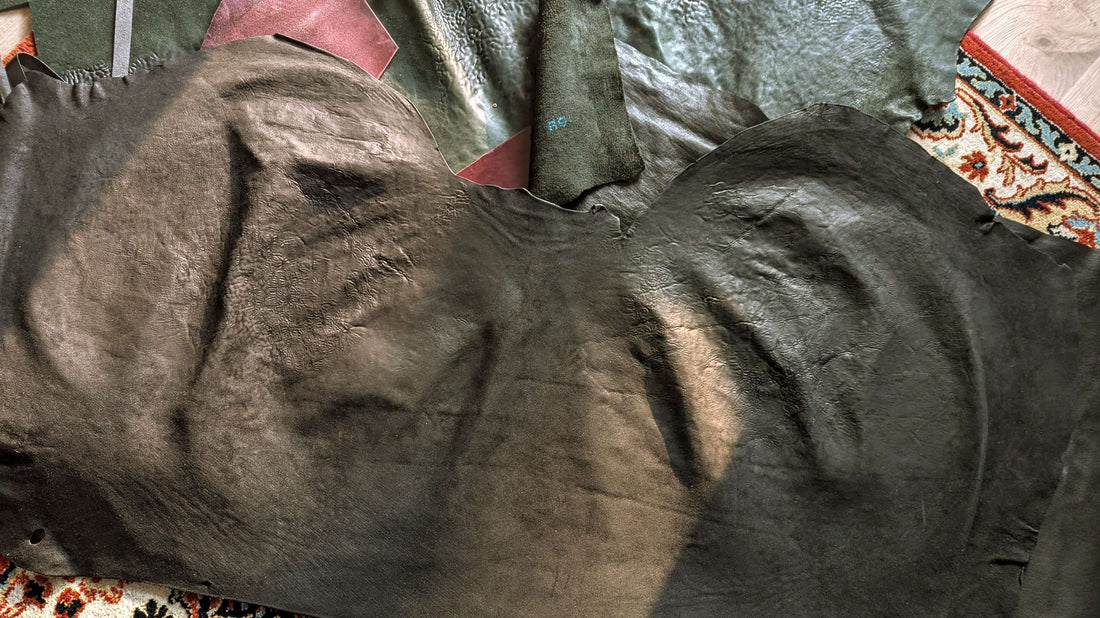
Leather and hardware
Here are my principles and choices in leather and hardware. Some may seem obvious, but each one matters because of the intention behind it.
It’s also important to note that principles alone don’t guarantee high quality or satisfaction. Quality comes from the attention and care put into the work, and in how you treat the items you buy and love.
Let's start with leather
Mostly vegetable-tanned leather
Mostly, that means around 95%. Chrome-tanned leather has its place, it’s often more resistant to water damage and can be more resilient in certain use cases. But vegetable-tanned leather lasts longer, develops much more character and patina, and is simply more fun to work with. It feels like a more honest material, with real life and texture in it.
Aniline dyes and full-grain leather
It might be more accurate to call them soluble dyes — the key point is that they saturate and impregnate the leather, unlike heavy surface pigments. What matters most to me is being able to feel the actual surface of the leather, without any coating or correction of the grain.
It also means you see and feel all the natural imperfections: scars, bites, texture... and again, it feels more alive.
Horse leather
It just has a certain je ne sais quoi that speaks to me. I can spot and feel it instantly by the texture. Plus, materials like shell cordovan and culatta only come from horse hides. I’m curious to try other exotic leathers like kangaroo, but culatta remains my main choice. I usually source vegetable-tanned horse leather from a few select tanneries in Italy.
Deadstock leather
Italy is renowned for its textiles and leather, and much of the luxury manufacturing still happens there. Occasionally, you can find rare and beautiful leathers in designer deadstock warehouses — materials left over from the collections of brands like Rick Owens or Ann Demeulemeester. I sometimes use these leathers too.
It’s also worth noting that nearly all leather is a byproduct of the meat and dairy industries. No animals are raised solely for their hides. Properly made leather is a sustainable material — and a well-crafted leather item should last a lifetime.
Hardware: zippers, buttons and more
I’m very sensitive to tactile details. Our fingers can detect tiny changes in texture and unevenness that often go unnoticed by the eyes. For me, how something feels is just as important as how it looks.
Zippers
There are a few companies known for making the best zippers: Riri, Raccagni, and Excella. Right now, I prefer Excella because their sliders feel the nicest I’ve ever used. I choose heavy-duty zippers that suit my designs perfectly — and honestly, using them can become a bit addictive.
Buttons
There are plenty of button options out there, and sometimes even inexpensive buttons can do the job. You can also find decent Italian PRYM buttons in retail. But some buttons are on a whole different level. For example, Cobrax gives the best tactile experience — they actually feel easier to close than to open, which makes them feel even more secure. Then there are Japanese buttons from Hasi Hato and Crown, similar to PRYM but with a little extra finesse. Some of these Japanese snaps even have separate lathe-machined bottom parts made by the Oka factory.

Chinese manufacturers can also deliver amazing products when you know where to look, like pure copper snaps that I’m excited to see age over time.
Chains, shackles, rings
Most of these come from China, but the key is quality control and knowing your materials. My go-to metals are stainless steel, brass, and bronze. Whenever I can, I prefer natural textures over galvanized plating. That said, there’s nothing wrong with electroplating or zinc alloys when they’re done right.
Soon, I’ll also be offering custom-made hardware through collaborations with local blacksmiths and jewelers.
Stitching and thread
All items are stitched completely by hand using traditional saddle stitching. This technique uses two needles and creates a seam that’s stronger than any machine stitch. It also means that if a thread ever breaks, it won’t unravel the entire seam.
For thread, I use waxed braided bonded polyester by Ritza and MTB. These are some of the best leatherwork threads available and such a pleasure to work with.
I’ll never use a sewing machine not because I dislike them, but because hand-stitching gives me more control and satisfaction. It’s part of what makes the craft feel alive.
Finishing
Edges are carefully beveled, burnished, and waxed by hand. This not only makes them more durable, but also smooth to the touch and better-looking over time.
I finish the leather with natural oils and waxes, depending on the type. There are no plastic coatings only soluble dyes and burnishing. The idea is to let the material breathe and age in its own way—developing patina, color shifts, and wear patterns unique to how it’s used.
